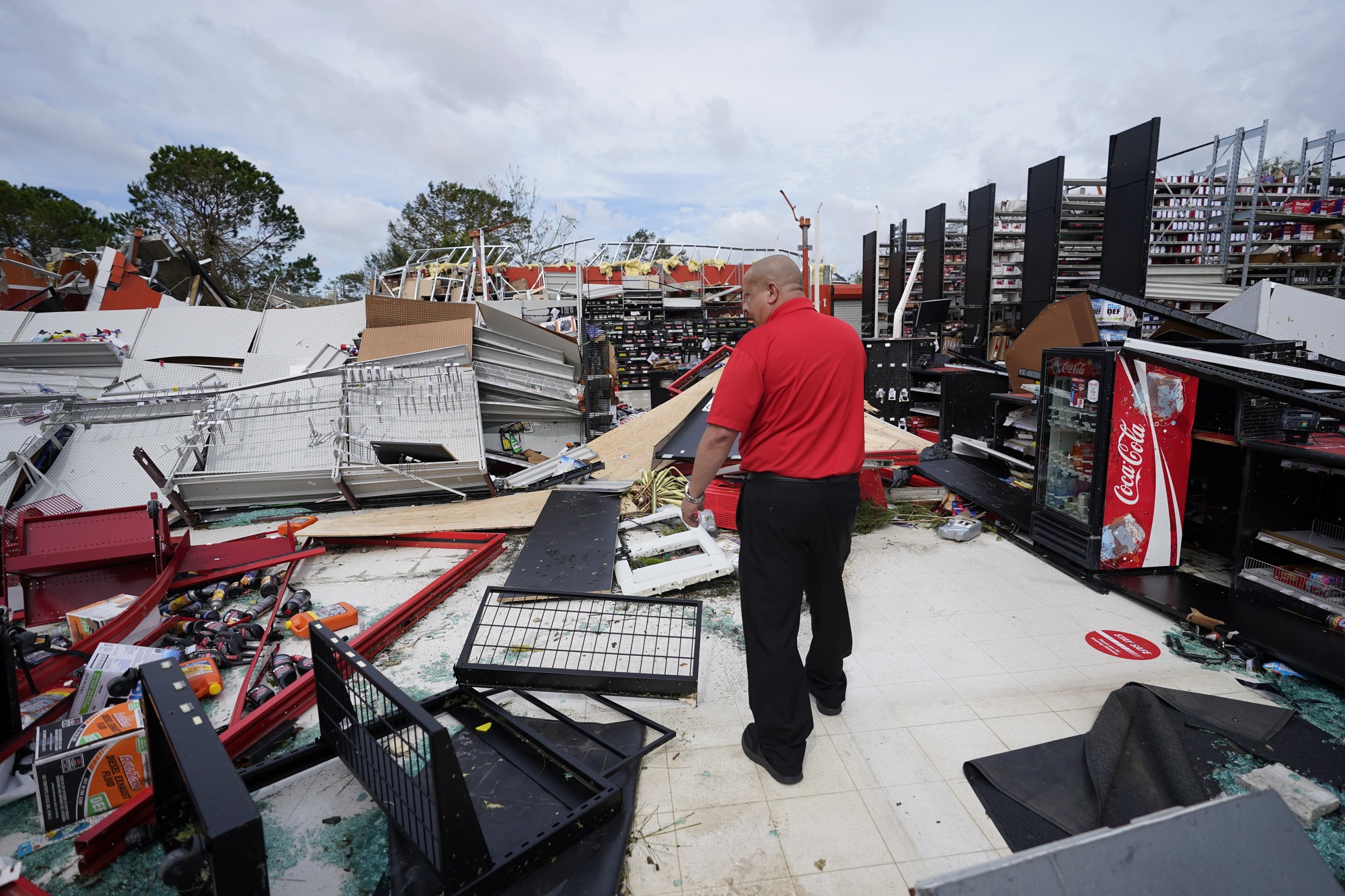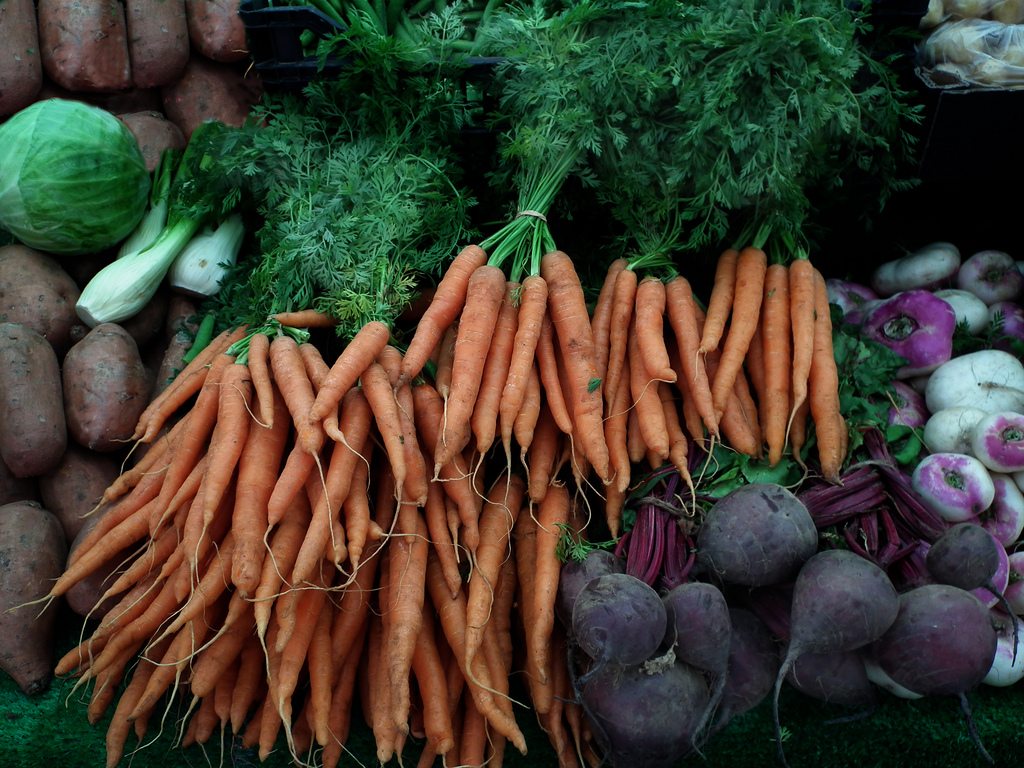
(AP Photo/Gerald Herbert)
As the storm moves north, concern increases for cattle ranchers who’ve been battered by previous hurricanes and poultry processors without power.
Early Thursday morning, at around 1:00 a.m., Hurricane Laura made landfall in southwest Louisiana as a Category 4 hurricane with sustained winds of 150 miles an hour. It was the most powerful storm ever to make landfall in the state, Governor John Bel Edwards said at a news conference Thursday afternoon. Laura has since been downgraded to a tropical storm.
A retail employee surveys the damage to his facility on Thursday, Aug. 27, 2020, in Lake Charles, La., in the aftermath of Hurricane Laura.
And although the much-feared massive, 20-foot-storm surge didn’t materialize, most of the state experienced tropical-storm-force winds, which downed power lines and streetlights, blew away roofing, and scattered debris across roads and bridges. Four people died.
Search and rescue crews are now combing the state, and officials took to the air after the press conference for surveys of the damage in hard-hit Calcasieu, Cameron, and Vermillion Parishes.
As of Thursday evening, much of Louisiana is without power, with just under 600,000 homes and businesses in the dark. Water systems may be down, Edwards said, and in the days ahead, residents who lost power for 24 hours may become eligible for emergency food aid, or Disaster Supplemental Nutrition Assistance Program (D-SNAP), pending USDA approval. The governor encouraged residents to pre-register for the program, but added that SNAP recipients already receiving “emergency allotments” for Covid-19 will not be eligible for further assistance.
“We have thousands and thousands of our fellow citizens whose lives are upside down, because their business and or homes have been damaged,” Edwards said. “We have a lot of work to do, but we’re in better shape than might have been the case.”
Evacuees from southern Louisiana and eastern Texas have come to neighboring food banks for help.
“We are doing our dead level best to get some food to those people.”
The Galveston County Food Bank, a large organization that normally assists around 80 agencies to feed an average of 20,000 people a month in the Houston area, had planned to shut its doors on Thursday for the hurricane’s arrival. But when the area was spared and skies stayed clear, the food bank quickly opened its doors and scrambled to get its agencies food and water.
The food bank’s phones started ringing at 6:00 a.m. on Thursday morning. On the other end were evacuees looking for assistance, said Donnie Van Ackeren, president and CEO.
“A lot of those folks are held up in their cars and campers,” said Van Ackeren. “And we are doing our dead level best to get some food to those people.”
Ackerman said the lines outside his food bank were easily double what he normally sees.
“Our phone has been going crazy all day with people looking for help,” he said. “The sheer volume of people today has been enormous.”
Van Ackeren said Thursday’s activity reminded him of past disasters, like Hurricane Katrina, when many evacuees had fled to Houston. But this disaster compounds the economic affects of another distaster—the pandemic. Last month, Galveston County Food Bank fed an extra 9,000 people.
“The devastation is real,” said Van Ackeren. “It’s a blessing we were spared but my heart still breaks for all those people who are having to go through it and deal with it. But we’re here to help in any way that we can.”
Elsewhere, in Cameron Parish, the small, coastal area that was battered early on Thursday morning, cattle ranchers had moved their herds to higher ground, hoping to outrun the predicted storm surge. The small parish boasts more cows than people—16,000 head of cattle, according to Avery Davidson, communications director of the Louisiana Farm Bureau, to a population of under 7,000 people. Davidson said he struggled to reach ranchers and other farmers due to power outages and flooded roads.
“We’re not going to really know what kind of losses there are until we get folks on the ground,” he said.
But to Davidson, the hurricane’s toll is bigger than numbers—it’s about further losses to a way of life. Cameron lost a once-thriving fishing industry after it was battered by Hurricane Rita in 2005, a storm that destroyed boats, docks, and icehouses, and left the area’s infrastructure in tatters. He’s not eager to see cattle ranching disappear, too.
“If it’s one person who had 300 head of cattle, and they lost all 300 head, that person’s not in business, and their livelihood is gone,” Davidson said. “And when their livelihood goes away, it’s a person who goes away, and it’s a culture that goes away. And that’s what we really don’t want to see.”
Davidson voiced concerns that, as the storm moves north and knocks out power, the state’s billion-dollar poultry industry and chicken farms in Natchitoches and Farmerville could suffer enormous losses of animal life without electrical cooling fans and functioning water systems.
In his press conference, Edwards warned of more power outages and other damages in the coming days. Much of Louisiana is under a tornado warning, and the storm’s outer bands are pushing water toward the coastal Vermillion and Iberia Parishes, where sea levels continue to rise. Flash-flood warnings are in effect for New Orleans, and cities as far north as Memphis, Tennessee, as the storm charges north and east.



